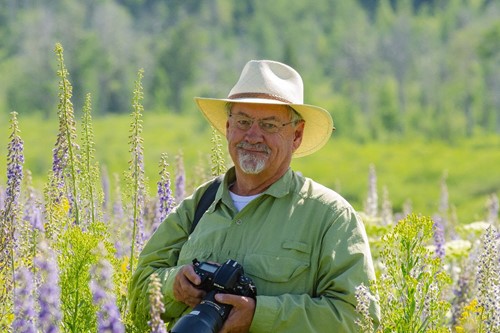Environmental Hero
Tom Mangelsen

Guided by a deep conservation ethic, Tom Mangelsen is one of the most awarded and influential nature photographers in the world. He has traveled throughout the natural world for over 45 years, observing and photographing some of Earth’s last great wild places. One particular project focused on a mountain lion family and inspired Tom to co-found The Cougar Fund, a non-profit that strives for the conservation of this species and other carnivores through education and advocacy.
Growing up near the Platte River in Nebraska, Tom gained an appreciation for nature early in his life as he'd watch flocks of waterfowl and cranes migrate with his dad. He majored in biology as an undergraduate and zoology as a graduate student in college. While in graduate school at Colorado State University he became involved in documentary film making. In 1978, Mangelsen opened his first Images of Nature® gallery in Jackson, Wyoming, and he continues to capture some of the most magnificent wildlife moments in spectacular style. We were thrilled to work with Tom and to feature some of his beautiful photos in our book Grizzly 399.
"The diversity of life on this planet is a miraculous gift. What gives me the greatest joy is being able to share glimpses of it. I hope my work stands as a testament to the power of timeless beauty and as a reminder that we must not take our fellow wild creatures for granted.”
—Thomas D. Mangelsen
All photos provided by Tom Mangelsen.
GKC: When did you first decide that photography was the career and media you wanted to pursue?
Tom: I bought my first camera in 1969 after graduating from Doan College in Nebraska. My graduate advisor, Paul Johnsgard, was the world’s authority on waterfowl and taught me the basics of bird photography. It was a hobby for me for about 10 years before I seriously thought about making a career out of it, which took another ten years.
GKC: It seems you intentionally focused on wildlife and their habitats as the subjects of your photography. Has conservation always been a purposeful intent or did that come later in your photography career?
Tom: I was interested in conservation before I ever bought a camera. Making photographs was a way I could express my concern and passion for the natural world.
GKC: What are some of your most memorable photography locations and adventures?
Tom: I have so many memorable photography adventures. My favorite locations are Africa, the Arctic, Greater Yellowstone and the prairies where I grew up.
GKC: What was the process for the selection of the 115 images for your The Natural World and how hard was it to select from your enormous library of images?
Tom: My associates and I edited some 25,000 panoramic images down to 115. The Natural World was broken down into 10 ecosystems so we had to select images to be representative of each place.
GKC: You have had a long career and traveled all over the world. What still makes you passionate for photography?
Tom: Spending time in wild places is my passion and capturing moments in time is what continues to drive me.
GKC: What have been some of your biggest challenges in achieving your vision for meaningful wildlife conservation?
Tom: The entire process of capturing meaningful images that people are inspired by and moved by is the biggest challenge. Getting the images out to the public via film, video or limited-edition prints is another hurdle. If people are moved emotionally by art then it is my hope they will also speak out against issues like climate change and for preserving wildlife and wild places.
GKC: Why do you care so much about Grizzly 399 and other animals (or bears)?
Tom: Grizzly 399 has become the poster child for all grizzlies. Her longevity and success as a mother with having 17 offspring and ability to interface with people near roads in the Teton Park has made her a “rock star.” Many millions of people from all over the world have witnessed 399 and her cubs for more than 15 years. She is intelligent, sentient and has emotions just like us. It is rare to see any bear in the wild today but 399 has given us the gift of seeing a grizzly in the wild.
GKC: What advice would you give to aspiring, future environmental/conservation-focused photographers and videographers?
Tom: Be passionate about whatever field or subject that interests you the most. Today it is more productive and successful to specialize in fewer areas and subjects not necessarily collecting images from every continent. That’s been done. Be patient, persistent and caring for your subjects and landscapes they inhabit.
GKC: What do you see as your single biggest impact toward wildlife conservation?
Tom: I don’t believe I have a single biggest impact but hopefully a combination of interests and issues. The Platte River, whooping cranes, polar bears, cougars and grizzlies stand out. Other endangered species like tigers, mountain gorillas, elephants, rhinos and places like Antarctica and Africa are all a concern for me.
GKC: As you look back at your career, body of work, and ongoing photographic pursuits, what would you like your legacy to be?
Tom: He tried to make a difference.
GKC: Tom, is there anything else you would like to add?
Tom: Not much else to say.
---
For more on Tom Mangelsen and his amazing photographs, check out these links:
A Life in the Wild traveling museum exhibition: Mangelsen.com/museum
The Legacy Reserve Collection: Mangelsen.com/legacy
For more about the dedicated individuals making an impact at The Cougar Fund, check out their page.
We worked with Tom Mangelsen on our books Grizzly 399 and Grizzly 399's Hibernation Pandemonium. Proceeds from both of these books go to support The Cougar Fund.




About the author
Lorielle Peterson